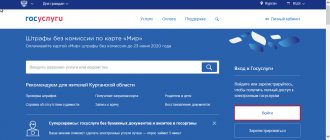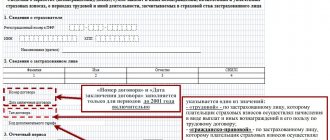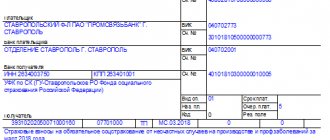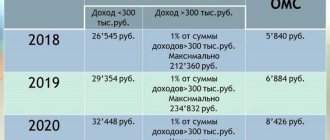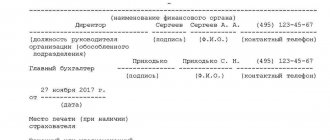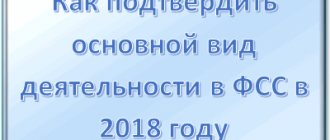Tariff of organizations that have not confirmed their main type of activity
The list of policyholders (enterprises and individual entrepreneurs) who can use LT to accrue SV in the Pension Fund, and who are exempt from paying contributions to the Social Insurance Fund and the Federal Medical Insurance Fund, is indicated by the legislator in Federal Law No. 212, Art.
58. These include entities engaged in activities:
- commercial;
- for the sale of medical and medicinal products, health products, including orthopedic;
- non-profit;
- charitable or public.
The activity covered by the benefit must be the main one of the policyholder. Moreover, the main one should be only one type of activity, and not several. Income from core activities is calculated based on the provisions of the Tax Code, Art. 346.15. For the application of LT, the legislator does not allow combining income related to different types of activities included in different classes according to OKVED.
When the storage system, in addition to the simplified tax system, uses another tax system, but due to the simplification its activities fall under the LT, it has the right to apply them. The legislator also does not establish restrictions on other types of activities for storage systems on the simplified tax system, which may fall under another tax system.
Payment of insurance premiums is mandatory for all legal entities and private entrepreneurs, so it is important to understand which ones must be indicated
BCC for pension contributions to the Federal Tax Service in 2020
.
In our article you can find out whether individual entrepreneurs submit the SZV-M report.
For example, “simplified” two systems are used: UTII and simplified tax system. For its core activity, which is on the “imputed” side, its profitability is more than 70%. If this type of activity is preferential under the simplified tax system, then PT can be applied to it.
If a “simplified” person has less than 70% of their income from their main activities, which falls under benefits, during the reporting period, they will have to accrue SV based on general tariffs, i.e., they will lose the right to use LT.
If the storage system on the simplified tax system erroneously calculated contributions for LT, although it should have on a general basis, then after identifying the error, he will have to make an additional payment. In this case, no penalty will be charged either.
Changed size
fixed contributions for individual entrepreneurs in 2020
. Find out from our article what contribution amount is relevant this year.
You will find a sample copy of SZV-M for employees in 2020 here.
For the calculation form for insurance premiums in 2020, see this article.
Since 2020, benefits on insurance premiums in 2020 for the simplified tax system according to OKVED have been frozen. From January 1, 2020, most companies and individual entrepreneurs will pay insurance premiums at a general rate of 30%. Benefits were retained only for non-profit and charitable organizations.
No video.
| Video (click to play). |
The abolition of reduced tariffs for insurance premiums in 2019 under the simplified tax system entails a change in the list of types of activities according to OKVED for which preferential tariffs can be applied. However, reduced preferential tariffs in 2020 still remained for some types of activities. Thus, for socially oriented non-profit and charitable organizations that use the simplified tax system, the tariff rate remains at 20%.
One of the main changes in the field of insurance premiums, effective from 2020, is the increased maximum base for the amount of payments in favor of the employee. Now the limits are set in the amount (clauses 4-6 of Article 421 of the Tax Code of the Russian Federation, Decree of the Government of the Russian Federation of November 28, 2018 N 1426):
- RUB 1,150,000 for contributions to compulsory pension insurance (was 1,021,000 rubles);
- 865,000 rub. for contributions to VNiM (was 815,000 rubles).
But in addition, the rates of insurance premiums calculated from salaries and other remunerations of employees and persons with whom civil contracts have been concluded have changed.
As you remember, the Tax Code previously stipulated that the aggregate tariff of 30%, at which the majority of insurers calculate premiums, would be in effect temporarily - in the period from 2020 to 2020. (Article 426 of the Tax Code of the Russian Federation). And after the specified period, the tariff for compulsory health insurance contributions was supposed to increase by 4% to 26%, and the total tariff - from 30% to 34% (clause 1, clause 2, art.
- for OPS - 22% within the maximum base value and 10% if it is exceeded;
- at VNiM – 2.9%;
- for compulsory medical insurance – 5.1%;
- for injuries - from 0.2% to 8.5% (Article 1 of the Law of December 22, 2005 N 179-FZ, Article 1 of the Law of December 31, 2017 N 484-FZ).
As already mentioned, the basic insurance premium rates for 2019 have not changed. And this is certainly good news. But with reduced tariffs the situation is not so rosy.
Starting from 2020, several categories of policyholders are switching from reduced tariffs to basic ones. These include:
- organizations and individual entrepreneurs on the simplified tax system, conducting certain types of activities (clause 5, clause 1, article 427 of the Tax Code of the Russian Federation);
- organizations and individual entrepreneurs on UTII with a license for pharmaceutical activities, incl. pharmacies (clause 6, clause 1, article 427 of the Tax Code of the Russian Federation);
- Individual entrepreneur on a patent (clause 9, clause 1, article 427 of the Tax Code of the Russian Federation).
All listed policyholders, as of 2020, must also pay premiums at a rate of 10% if benefits to their employees during the calendar year exceed the base limit.
Business companies and business partnerships that are involved in the implementation of the results of intellectual activity, as well as organizations and individual entrepreneurs that have agreements with special economic zones on the implementation of technology-innovative activities, from 2020 must pay contributions to the compulsory public insurance at a rate of 20%, and not at 13 %, as it was in 2020 (clauses 1,2, clause 1, clause 1, clause 2, article 427 of the Tax Code of the Russian Federation).
The remaining policyholders who had the right to pay premiums at reduced rates in 2020 have the right to apply them in 2019.
In the article in the magazine “Simplified” read all about the benefits on insurance premiums in 2020 for the simplified tax system according to OKVED. We have shown preferential types of activities in the table according to OKVED-2019 codes and presented simplified insurance premium rates for 2020, taking into account all changes in legislation (the laws have been signed).
Kind of activity
OKVED-2 code
Food production
Production of soft drinks, production of mineral waters and other bottled drinking waters
Textile production
Production of leather and leather products
Wood processing and production of wood and cork products, except furniture, production of straw products and wicker materials
Production of paper and paper products
Production of chemicals and chemical products
Production of medicines and materials used for medical purposes
Production of rubber and plastic products
Production of other non-metallic mineral products
Production of profiles using cold stamping or bending
Wire production using cold drawing method
Production of finished metal products, except machinery and equipment
Production of computers, electronic and optical products
Electrical Equipment Manufacturing
Production of machinery and equipment not included in other categories
Production of motor vehicles, trailers and semi-trailers
Manufacture of other vehicles and equipment
Production of musical instruments
Production of sporting goods
Production of games and toys
Production of medical instruments and equipment
Production of products not included in other groups
Repair and installation of machinery and equipment
Wastewater collection and treatment
Collection, processing and disposal of waste; processing of secondary raw materials
Construction of engineering structures
Specialized construction works
Vehicle maintenance and repair
Retail trade of medicines in specialized stores (pharmacies)
Retail trade of products used for medical purposes, orthopedic products in specialized stores
Activities of land and pipeline transport
Water transport activities
Air and space transport activities
Warehousing and auxiliary transport activities
Postal and courier activities
Production of films, videos and television programs
Activities in the field of television and radio broadcasting
Activities in the field of telecommunications
Computer software development, consulting services in the field and other related services
Activities in the field of information technology
Real estate management on a fee or contract basis
Research and development
Activities of travel agencies and other organizations providing services in the field of tourism
Maintenance activities for buildings and grounds
Health activities
Residential care activities
Providing social services without providing accommodation
Activities of cultural and art institutions
Activities of libraries, archives, museums and other cultural facilities
Activities of sports facilities
Activities of sports clubs
Other activities in the field of sports
Occupational risk class | Insurance rate, % | Occupational risk class | Insurance rate, % |
| I | 0,2 | XVII | 2,1 |
| II | 0,3 | XVIII | 2,3 |
| III | 0,4 | XIX | 2,5 |
| IV | 0,5 | XX | 2,8 |
| V | 0,6 | XXI | 3,1 |
| VI | 0,7 | XXII | 3,4 |
| VII | 0,8 | XXIII | 3,7 |
| VIII | 0,9 | XXIV | 4,1 |
| IX | 1,0 | XXV | 4,5 |
| X | 1,1 | XXVI | 5,0 |
| XI | 1,2 | XXVII | 5,5 |
| XII | 1,3 | XXVIII | 6,1 |
| XIII | 1,4 | XXIX | 6,7 |
| XIV | 1,5 | XXX | 7,4 |
| XV | 1,7 | XXXI | 8,1 |
| XVI | 1,9 | XXXII | 8,5 |
Tariffs by professional risk classes – 2020
Tariffs are set for policyholders annually. To do this, organizations at the end of the reporting year (before April 15) inform the Social Insurance Fund what type of activity was their main activity in the past year (read more about confirming the main type of activity in the Social Insurance Fund). If a company has only one type of activity, then it is the main one. When the activities are varied, it is necessary to determine the share of each type in the total revenue of the enterprise - the main one will be the one that accounted for the largest part of last year's income or production volume. Then the occupational risk class according to OKVED of this main type of activity is determined.
For example, the company in 2020 was mainly engaged in trading products (70% of total revenue). According to OKVED 46.36, this is class 1 of professional risk, and those who fall into it are subject to an insurance rate of 0.2%. In 2020, the production of bakery products (65% of revenue), corresponding to occupational risk class 2 according to OKVED 10.7, came to the fore. This became the basis for the FSS fund to increase the occupational risk class - the 2020 tariff for the company will be 0.3%.
Tariff rates for pro-free insurance classes given in the table below will be relevant in the period 2018-2020. (Article 1 of Law No. 484-FZ dated December 31, 2017).
Classes of professional risk and insurance rates (%) for insurance premiums for “injury”, effective in 2020:
| Class 1 professional risk |
| Class 2 professional risk |
| Class 3 professional risk |
| Class 4 professional risk |
| Class 5 professional risk |
| Class 6 professional risk |
| Class 7 professional risk |
| Class 8 professional risk |
| Class 9 professional risk |
| Class 10 professional risk |
| 11th class of professional risk |
| Class 12 professional risk |
| Class 13 professional risk |
| Class 14 professional risk |
| Class 15 professional risk |
| Class 16 professional risk |
| Class 17 professional risk |
| Class 18 professional risk |
| Class 19 professional risk |
| Class 20 professional risk |
| 21 occupational risk classes |
| Class 22 professional risk |
| Class 23 professional risk |
| Professional risk class 24 |
| Professional risk class 25 |
| Class 26 professional risk |
| Class 27 occupational risk |
| Class 28 professional risk |
| Class 29 professional risk |
| Professional risk class 30 |
| 31 occupational risk classes |
| Class 32 professional risk |
Occupational risk classes and insurance rates are related concepts: the higher the risk, the more significant the insurance premiums for compulsory social insurance against industrial accidents and occupational diseases are for the enterprise budget. You will learn from the article what professional risk classes and insurance rates are and what methods exist for determining them.
Preferential amounts of payments under the simplified taxation system
Insurance premium rates for 2020 are established by Articles 426–429 of the Tax Code of the Russian Federation. In particular, these articles define reduced insurance premium rates for those who are connected with the simplified taxation system (STS) in 2017. Organizations and individual entrepreneurs using the simplified tax system have the right to apply reduced tariffs if they are engaged in certain types of activities. In this case, two conditions must be met (according to subparagraph 5 of paragraph 1, subparagraph 3 of paragraph 2, paragraphs 3 and 6 of Article 427 of the Tax Code of the Russian Federation):
- income from this type of activity from the beginning of the year constitutes at least 70 percent of the total amount of all receipts for the reporting period;
- the total amount of income does not exceed 79,000,000 rubles.
If the specified conditions are met, an organization or individual entrepreneur using the simplified tax system can calculate insurance premiums in 2020 at reduced rates.
| Reduced tariffs under the simplified tax system in 2020: rates | |||
| Conditions of preferential tariff | Insurance premium rates 2020 | ||
| Pension | Social | Medical | |
| Organizations and entrepreneurs on a simplified basis that are engaged in certain types of activities and if their cumulative income for the calendar year does not exceed 79 million rubles. | 20% | — | — |
| Non-profit organizations that use the simplified approach and operate in the field of: – social services for the population; – scientific research and development; – education; – healthcare; – culture and art (the activities of theaters, libraries, museums and archives); – mass sports (except professional). Exception: state and municipal institutions | 20% | — | — |
| Charitable organizations simplified | 20% | — | — |
Preferential tariffs that “simplified” residents can apply in 2019 were announced by the legislator in the Tax Code, Art. 426–429. Among other things, in order to apply a reduced storage tariff, the conditions specified in Art. 427, paragraphs 1–3, 6.
Article 426. Insurance premium rates in 2020 - 2020
Article 427. Reduced rates of insurance premiums
Article 428. Additional tariffs of insurance premiums for certain categories of payers
It says there that:
- When engaged in a certain type of activity, thanks to which it is allowed to use a preferential tariff (LT), income from it must be no less than 70% of all receipts in the reporting period.
- the total amount of income from the storage system should not exceed 79 million rubles.
The legislator proposes to use LT when calculating SV in the PF in the amount of 20%. If the amount of payments to an employee or other individual in 2019 from the beginning of the reporting calendar year exceeds the allowable amount of 876 thousand rubles, then pension contributions are not required to be accrued on his income. Contributions to the Social Insurance Fund and the Federal Compulsory Medical Insurance Fund are not paid by “simplified” workers at all. The exception is SVs, which individual entrepreneurs on the simplified tax system pay for themselves; preferential tariffs do not apply to them.
How to calculate the contribution for injuries to the Social Insurance Fund: formula and example
In 2020, employers calculate injury insurance premiums every month (taking into account accruals for the elapsed 30 or 31 days). To calculate payments you need to use the following formula:
Insurance premiums = B x Tariff, where:
- B - contribution base (the amount of money received by the employee, on the basis of which the contribution is calculated). There are no restrictions on this amount in current legislation;
- T is the tariff rate for contributions.
To calculate the base you must use the formula:
B = Payments to an individual under an employment agreement (or civil contract) - non-taxable payments.
For example: Panda LLC has such activities as hunting, catching and shooting wild animals, including the provision of services in these areas. The activity code according to OKVED is 01.70. Occupational risk class - 32. In March 2020, the organization awarded employees a salary of 1,350,000 rubles. Payments include financial assistance in the amount of 21,000 rubles. What amount of contributions will need to be paid to the Social Insurance Fund?
1. Let's calculate the base for calculating payments:
B = 10 = 1,329,000 rubles.
The tariff corresponding to class 32 is 8.5%.
2. The amount of deductions for injuries will be as follows:
Insurance premiums = 1,329,000 × 8.5% = 112,965 rubles will need to be paid for injuries to the Social Insurance Fund.
New reporting form
On January 1, 2020, Rosstandart introduced OKVED2 instead of OKVED1. However, despite the transitional keys, not all old activity codes coincided with the new ones. Because of this, starting from 2020, not all organizations could apply reduced insurance premium rates.
| OKVED code 2 | Name of the grouping of activities from the list given in the Tax Code |
| 10 | Food production |
| 11.07 | Production of soft drinks, production of mineral waters and other bottled drinking waters |
| 13 | Textile production |
| 14 | Manufacture of wearing apparel |
| 15 | Production of leather and leather products |
| 16 | Wood processing and production of wood and cork products, except furniture, production of straw products and wicker materials |
| 17 | Production of paper and paper products |
| 20 | Production of chemicals and chemical products |
| 21 | Production of medicines and materials used for medical purposes |
| 22 | Production of rubber and plastic products |
| 23 | Production of other non-metallic mineral products |
| 24.33 | Production of profiles using cold stamping or bending |
| 24.34 | Wire production using cold drawing method |
| 25 | Production of finished metal products, except machinery and equipment |
| 26 | Production of computers, electronic and optical products |
| 27 | Electrical Equipment Manufacturing |
| 28 | Production of machinery and equipment not included in other categories |
| 29 | Production of motor vehicles, trailers and semi-trailers |
| 30 | Manufacture of other vehicles and equipment |
| 31 | Furniture manufacture |
| 32.2 | Production of musical instruments |
| 32.3 | Production of sporting goods |
| 32.4 | Production of games and toys |
| 32.5 | Production of medical instruments and equipment |
| 32.9 | Production of products not included in other groups |
| 33 | Repair and installation of machinery and equipment |
| 37 | Wastewater collection and treatment |
| 38 | Collection, processing and disposal of waste, processing of secondary raw materials |
| 41 | Building |
| 42 | Construction of engineering structures |
| 43 | Specialized construction works |
| 45.2 | Vehicle maintenance and repair |
| 47.73 | Retail trade of medicines in specialized stores (pharmacies) |
| 47.74 | Retail trade of products used for medical purposes, orthopedic products in specialized stores |
| 49 | Activities of land and pipeline transport |
| 50 | Water transport activities |
| 51 | Air and space transport activities |
| 52 | Warehousing and auxiliary transport activities |
| 53 | Postal and courier activities |
| 59.1 | Production of films, videos and television programs |
| 60 | Activities in the field of television and radio broadcasting |
| 61 | Activities in the field of telecommunications |
| 62 | Computer software development, consulting services in the field and other related services |
| 63 | Activities in the field of information technology |
| 68.32 | Real estate management on a fee or contract basis |
| 72 | Research and development |
| 75 | Veterinary activities |
| 79 | Activities of travel agencies and other organizations providing services in the field of tourism |
| 81 | Maintenance activities for buildings and grounds |
| 85 | Education |
| 86 | Health activities |
| 87 | Residential care activities |
| 88 | Providing social services without providing accommodation |
| 90.04 | Activities of cultural and art institutions |
| 91 | Activities of libraries, archives, museums and other cultural facilities |
| 93.11 | Activities of sports facilities |
| 93.12 | Activities of sports clubs |
| 93.13 | Activities of fitness centers |
| 93.19 | Other activities in the field of sports |
| 95 | Repair of computers, personal and household items |
| 96 | Activities providing other personal services |
If you find an error, please highlight a piece of text and press Ctrl Enter.
Employers make “injury” contributions in accordance with insurance rates. However, a discount or surcharge may be applied to the tariff (clause 1, article 22 of the Federal Law of July 24, 1998 No. 125-FZ).
The size of the discount (surcharge) is determined by a formula that involves three indicators:
- The ratio of the Social Insurance Fund's expenses for the payment of benefits for all insured events for the policyholder and the total amount of accrued contributions;
- Number of insured events per thousand employees;
- The number of days of temporary disability for the policyholder per insured event (excluding cases of death).
| Change | Content |
| Expanding the rights of the Social Insurance Fund | Since 2020, the Social Insurance Fund has been vested with the following rights: • demand explanations from policyholders regarding contributions; • maintain control over the receipt of funds; • calculate the amount of insurance premiums, etc. |
| The collection procedure has been established | The Basic Law - 1998 No. 125-FZ - was supplemented with new articles that regulate methods of collecting arrears, deferments, accrual of penalties, etc. |
| The calculation procedure has been specified | Terms, as well as settlement and reporting periods, are determined at the legislative level |
| Control over payment of contributions has been tightened | Law No. 125-FZ has been supplemented with rules on conducting desk audits, recording audit results, etc. |
Also see: Reimbursement of Workwear Costs through Contributions: What Has Changed.
Calculations for contributions to social (medical, pension) insurance are now submitted to the tax authorities. Since 2018, control over them has been entrusted to the Federal Tax Service (except for payments “for injuries”).
Changing the insurance rate
Discounts
. Resolution No. 524 allows the employer to receive discounts from the Social Insurance Fund. The maximum discount is 40%. Apply for a discount no later than November 1st. You can get a discount if your company was registered before 2014 and all payments of contributions were timely. A prerequisite is the absence of debt.
The discount percentage depends on the indicators for the previous three years:
- the ratio of payments received from the Social Insurance Fund and contributions paid;
- number of injuries and illnesses per thousand employees;
- average length of sick leave per insured event.
The optimal values of the indicators are determined by FSS Resolution No. 67. Compliance with the specified values will increase the amount of the discount received. If the conditions are met, then you can submit an application. The FSS will make a decision by December 1 and will provide a response within 5 days.
Privileges
. The Social Insurance Fund has established tariff benefits for employers hiring disabled people, as well as for public organizations of disabled people. They can receive an increased discount - 60% of the tariff rate. Apply for benefits by November 1st.
Allowances
. The Social Insurance Fund has provided not only bonuses, but also an increase in payment amounts. The premium is assigned based on the same indicators of the FSS resolution No. 67. If the average values for the industry are exceeded, the FSS makes a decision on an increase to the insurance tariff. The decision is made by Social Insurance no later than September 1.
The cloud service Kontur.Accounting will help you prepare a report in Form 4-FSS and calculate insurance premiums for injuries, as well as benefits for accidents, medical examinations and special equipment for workplaces. Within 14 days you can keep records and reports for free, calculate salaries and use all the features of Kontur.Accounting.
Normative base
Legislative documents that enshrine the right of storage systems located on the simplified tax system to use reduced tariffs include:
- Federal Law No. 212 (07/24/09), regulating the obligation of policyholders to pay contributions to the Pension Fund, Social Insurance and Medical Insurance Fund. It also says that certain categories of payers have the right to use LT.
- Resolution of the Pension Fund No. 2p (16.01.14), which approves the calculation form and the procedure for filling it out to display accrued and paid contributions to the Pension Fund and the FFMOS.
- Order of the Ministry of Labor and Social Protection No. 107n (03/19/13), which approves the form for calculating accrued and paid SV in the event of an accident, work-related injury or occupational disease, in connection with maternity, for compulsory social insurance.
Benefits on insurance premiums in 2020 for the simplified tax system according to OKVED
| Old classifier | New classifier | Decoding |
| 15.1–15.8 | 10.1–10.8 | Food manufacturing activities |
| 24 | 20 | Chemical production |
| 73 | 72 | R&D activities |
| 80 | 85 | Educational activities |
| 85 | 86-88 | Activities in the field of social security and health care |
| 45 | 41 | Construction |
| 15.98 | 11.07 | Production of mineral waters and other non-alcoholic drinks |
| 17, 18 | 13, 14 | Textile and clothing production |
| 19 | 15 | Manufacturing of leather, leather products and footwear |
| 20 | 16 | Wood processing and production of wood products |
| 25 | 22 | Manufacturing of rubber and plastic products |
| 26 | 23 | Manufacture of other non-metallic mineral products |
| 28 | 25 | Manufacturing of finished metal products |
| 29 | 28 | Manufacturing of machinery and equipment |
| 30-33 | 28.23; 26.2; 27; 26; 32 | Manufacturing of electrical equipment, electronic and optical equipment |
| 34, 35 | 29 | Manufacturing of vehicles and equipment |
| 36.1 | 30 | Furniture making |
| 36.4 | 32.3 | Manufacturing of sporting goods |
| 36.5 | 32.4 | Making games and toys |
| 37 | 38 | Processing of recyclable materials |
| 60-64.0 | 49-53 | Activities in the field of transport services and communications |
| 92.61 | 93.11 | Activities of sports facilities |
| 92.62 | 93.19 | Other sports activities |
| 52.31-52.32 | 47.73; 47.74 | Retail trade in pharmaceutical and medical goods, orthopedic products |
| 50.2 | 45.2 | Vehicle maintenance and repair |
| 90 | 37 | Removal of waste water, waste, other similar activities |
| 93 | 96 | Providing personal services |
| 21 | 17 | Production of cellulose, wood pulp, paper, cardboard and products made from them |
| 36.3 | 32.2 | Making musical instruments |
| 36.6 | 32.9 | Other activities |
The full list of activities still “preferential” in terms of insurance premiums is contained in subparagraph. 5 p. 1 art. 427 Tax Code of the Russian Federation.
In 2020, for preferential activities, contributions to compulsory health insurance are accrued at a rate of 20%, and compulsory medical insurance and VNiM insurance are not paid.
Read more about the amounts of reduced insurance premiums here.
Note! Starting from 2020, this benefit ends, and simplified workers (with a few exceptions) will pay contributions at general rates.
Read about general insurance premium rates in this material.
Insurance rates by risk class
You need to pay contributions to the Social Insurance Fund so that the insurance fund will pay for rehabilitation and sick leave if an accident occurs in your company, an employee receives an injury or an occupational disease.
The amount of insurance payments in the Social Insurance Fund depends on the risk class. Each class has its own contribution rate for injuries, and the size of the contribution increases with the risk class. The insurance rates for each risk class are established by Federal Law No. 179. The minimum tariff in 2018 is 0.2%, the maximum is 8.5%. By law, tariffs must be changed and adjusted annually, but the 2006 tariffs have been in effect for 12 years.
| Risk class | Rate | Risk class | Rate | Risk class | Rate | Risk class | Rate |
| 1 | 0,2 | 9 | 1,0 | 17 | 2,1 | 25 | 4,5 |
| 2 | 0,3 | 10 | 1,1 | 18 | 2,3 | 26 | 5,0 |
| 3 | 0,4 | 11 | 1,2 | 19 | 2,5 | 27 | 5,5 |
| 4 | 0,5 | 12 | 1,3 | 20 | 2,8 | 28 | 6,1 |
| 5 | 0,6 | 13 | 1,4 | 21 | 3,1 | 29 | 6,7 |
| 6 | 0,7 | 14 | 1,5 | 22 | 3,4 | 30 | 7,4 |
| 7 | 0,8 | 15 | 1,7 | 23 | 3,7 | 31 | 8,1 |
| 8 | 0,9 | 16 | 1,9 | 24 | 4,1 | 32 | 8,5 |
In addition to the tariff rate, the size of the contribution is affected by the level of employee remuneration and the discounts and allowances assigned by the Social Insurance Fund.
List of documents for setting the tariff
In appearance, the report differs significantly from the previously used RSV-1. The document was developed according to the rules specific to tax reporting. Unlike the reports that it replaced (RSV-1 and 4-FSS), it does not contain information on debts and contributions paid.
In addition to general data, including information on accrued and paid income, insurance premiums, a single calculation contains pages for calculating possible benefits and reduced insurance rates.
To confirm the class of the enterprise, no later than April 15 of the current year, submit a number of documents to the Social Insurance Fund. Samples are presented in the appendices to the document, approved.
By Order of the Ministry of Health and Social Development of January 30, 2006 No. 55 (hereinafter referred to as Order No. 55). Requesting additional documents from an organization is an illegal request.
| Documentary form | Explanation |
| Application for confirmation of type of activity | Appendix No. 1 to Order No. 55 |
| Certificate confirming the type of activity | Appendix No. 2 to Order No. 55 |
| For organizations - a copy of the explanatory note to the balance sheet | The document is submitted by persons submitting reports to the Federal Tax Service in full. For small businesses, no document is required |
The documents are submitted simultaneously with a cover letter containing a list of forms. There is a personal procedure for submission through an authorized representative of the enterprise, by post or in the form of an electronic document.
Actions by users of public services are possible after receiving an enhanced digital signature and registration on the portal.
To use LT for calculating SV, there is no need to make an application to the territorial branch of the Tax Service and wait for permission from it. If the storage system has the right to do so on the basis of legislation, it can use it and charge contributions at reduced rates.
Documents can be requested in accordance with the Tax Code, Art. 93, paragraph 2:
- on paper with signatures of authorized persons and certified by a seal;
- electronic.
The demand form that is sent to policyholders was approved in May 2020, i.e. the inspector has no right to make a request orally or by telephone. The list of documents that various storage systems represent differs depending on the types of their activities.
For example:
- Storage managers engaged in production or working in the social sphere must submit documents that show information about their main activities, the amount of income, and their size as part of the total.
- For enterprises, except municipal and state ones, engaged in non-commercial activities, regional departments of justice provide information. They can report that an enterprise or individual entrepreneur has permission to engage in activities that do not correspond to its main goals.
- Department of Justice offices also report information about off-target activities involving charities and public organizations.
How to determine the occupational risk class
According to the class of professional risk, types of economic activity are divided into 32 groups - from the lowest risk to the highest. The risk class is determined by the level of industrial injuries, illness and insurance costs.
Organizations must confirm their main type of activity by April 15 (individual entrepreneurs do not need to do this). To do this, they submit an application to the Social Insurance Fund, a certificate confirming the type of activity, and an explanatory note to the reporting for the previous year. Changing the OKVED code during the year will not lead to a change in the insurance rate. However, if the FSS revises the risk class for your type of activity, then you will have to pay contributions at the updated tariff.
Based on these documents, the FSS will assign you the appropriate risk class. If you do not submit documents on time, the FSS will select the type of your activity that has the highest risk and set the tariff rate for it. Always submit documents on time, because the Social Insurance Fund has every right to set the maximum tariff and this cannot be challenged.
If you are working in one direction
— you can find out the risk group of your activity from the Order of the Ministry of Labor No. 851n, which presents a table of risk classes according to OKVED.
If activities are carried out in different areas.
Many entrepreneurs operate in various fields and fall under several risk classes at the same time. In this case, the risk class is determined by the main type of activity and the OKVED code specified during registration.
If it is not possible to determine the main type of activity
. This can happen with an equal share of all activities in the total turnover or equal revenue from each of them. In this case, the type of activity that has the highest class of professional risk will be recognized as the main one.
Transfer of the procedure to the control of the Federal Tax Service
Due to the fact that control over the payment of SV to the Pension Fund and FFMOS in 2019 is carried out by the Federal Tax Service, it will be necessary to submit a single calculation there. Contributions to the Social Insurance Fund are still transferred to Social Insurance accounts, and reporting is also submitted there.
To conduct a desk inspection, the inspector may request from the enterprise or individual entrepreneur:
- various documents confirming the activities in which he is engaged;
- explanations in written and oral form if contradictions are identified between the provisions of the law and the information provided.
Inspections are carried out randomly by inspectors, because the use of LT is one of the criteria on the basis of which selection for on-site inspections is carried out. Not only NS inspectors, but also fund employees can participate in a desk audit.
Basic provisions
Insurance premiums are mandatory types of payments that are paid by the employer to the Social Insurance Fund. Each director of the company must transfer a certain amount monthly, from which the employee will be paid compensation for industrial accidents and other types of benefits.
Cash compensation paid to workers is designed to protect the interests of employees in the event of an injury that occurs on the job. Such payments are regular and are paid individually for each person, but only upon the occurrence of an insured event.
If the personnel carries out labor activities under a civil contract, the obligation to pay the contribution may be removed. The exception is cases when the employment agreement provides for this condition.
If a work-related injury occurs, deductions will be made to the following types of payments:
- Wage.
- Separate allowances, vacation pay.
- Prize.
- One-time financial assistance, severance pay.
- Expenses for employee retraining.
- Various targeted government benefits and subsidies.
All of the above payments, in turn, are not subject to any deductions.
Different types of activities can fall into the same class, but only on the condition that similar indicators on occupational injuries were obtained for them. In connection with this class, the costs of insurance coverage are distributed.
The higher the established class, and the risk that the employee may receive one or another injury, the higher the rate is set.
Publishing activity, which has code 1 according to OKVED, is an activity with a low level of professional risk. In this regard, the tariff for insurance premiums for industrial injuries has a rate of 0.2%.
In turn, work at peat mining enterprises is characterized by a high level of injuries and is classified as class 18 according to the risk table. The insurance rate in this case is 2.3%.
How to find out your tariff
To determine your insurance premium rate for injuries in 2018, you must confirm the type of economic activity for the past period. That is, 2017. The policyholder must no later than April 16, 2020 (April 15 falls on a Sunday) send to the FSS:
- statement confirming the main type of activity;
- confirmation certificate;
- an explanatory note to the balance sheet for the past year (representatives of small businesses are relieved of this obligation).
In case of failure to submit the listed documents, the fund does not charge fines, however, FSS specialists will set the tariff independently. This right is granted to them by Order of the Ministry of Health and Social Development of Russia No. 55 of 2006.
Please pay special attention: it is impossible to challenge the maximum tariff assigned by the FSS (see Resolution of the Government of the Russian Federation No. 551). In this part, nothing has changed in 2020 regarding insurance premiums for injuries.
Also see “Confirming the main type of activity in the Social Insurance Fund in 2018: step-by-step instructions.”
What is “occupational risk class”
The Law “On Compulsory Social Insurance” dated July 24, 1998 No. 125-FZ defines occupational risk as the likelihood of harm to health or death of an employee associated with the performance of his work duties. The level of such injuries and illnesses among workers, coupled with the costs of social insurance coverage corresponding to a certain type of activity, forms an occupational risk class.
How many occupational risk classes are there? Today there are 32 of them, each of which is assigned to a specific group of activities: the greater the risk of injuries and occupational diseases of workers engaged in this area of business, the higher the pro-free class. The distribution of types of entrepreneurship by risk classes is carried out in accordance with the Rules, approved. Decree of the Government of the Russian Federation dated December 1, 2005 No. 713.
The size of the insurance tariff for “injury” depends on the class of professional risk assigned to the insured - the lowest tariff (0.2%) corresponds to class 1, and the highest (8.5%) corresponds to class 32 (FSS Insurance Tariff Law dated December 22 .2005 No. 179-FZ as amended on December 31, 2017).
OKVED in calculation of insurance premiums in 2020
As can be seen from the table above, organizations and individual entrepreneurs that are engaged in a certain type of business (activity) have the right to apply reduced tariffs in 2020.
Each type of such “preferential” activity must correspond to a specific code, which is assigned to it in accordance with the all-Russian classifier in force in 2020.
Preferential types of activities in 2020 are determined by subparagraph 5 of paragraph 1 of Article 427 of the Tax Code of the Russian Federation and the OKVED classifier 2. The OKVED classifier is no longer valid (Order of Rosstandart dated January 31, 2014 No. 14-st).
On the title page of the single calculation, OKVED is entered in a special field, the very name of which already indicates the use of the second classifier. Therefore, the use of any other OKVED is not required.
Until 2020, two all-Russian classifiers of types of economic activities of business entities were used: OK 2001 and OK 2014. This led to confusion regarding the correct use of codes in reporting.
Specifying old codes is considered an error. In this case, the report will be returned for correction.



